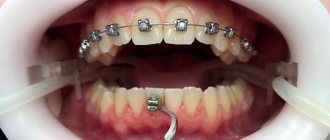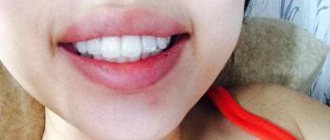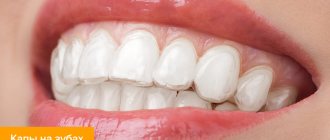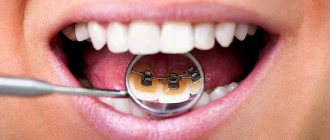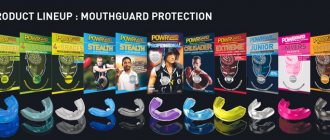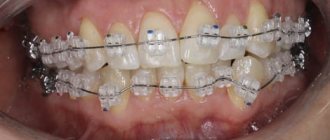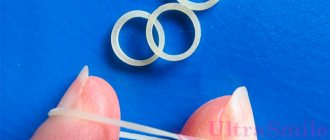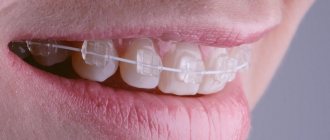Not every patient knows what a combined bracket system is. As a rule, treatment with braces is presented within the framework of the choice of one type of structure. Now you can learn in detail about the combined braces system and, perhaps, reconsider your views on correcting your bite.
A certain percentage of people consider these designs to be optimal for correcting occlusion in terms of price, quality and aesthetics. Speaking about the latter, one cannot help but notice that most often patients try to hide the presence of braces on their teeth as much as possible, sometimes agreeing to lingual braces, which cause a number of serious difficulties in everyday life.
Surely you know that braces are made from different materials. Each of them has a different impact on teeth, strength and appearance. Materials and prices vary. Most often you have to choose between the effectiveness of the treatment and the beauty of your smile, even during treatment. But how to combine the invisibility of transparent braces and the effectiveness of metal ones? More on this later.
What is a combined braces system?
So, what is a combined braces system? It is easy to guess that such a system is a composite version, which involves the presence of different materials in one design. So, on the front teeth located in the smile zone, the orthodontist installs transparent sapphire or ceramic braces that match the shade of the patient’s tooth enamel. Metal braces are installed on the remaining chewing teeth, which no one will see due to the location of these teeth.
Such bracket systems meet the most popular patient requirements:
- they are almost invisible when you smile;
- they are not very expensive;
- The effectiveness of bite correction is quite high.
But don't rush to conclusions. Combined systems are not suitable for all types of malocclusion, so you can only find out if such braces are right for you from your doctor.
Which braces are better: popular Ormco models
Here is a brief description of Ormco self-ligating and ligature metal bracket systems.
- Damon Q2 passive self-ligating braces went on sale in 2018. High-precision groove with improved rotation control, increased subligature space for elastic fixation and cap-mounted guides for precise positioning. Damon Q2 is compatible with Damon Q, Damon Clear2 and buccal tubes: the doctor flexibly uses the Damon ecosystem to achieve results. Damon Q2 – reliable metal braces with a high-precision groove.
benefits of Damon Q2
- Damon Q metal braces are Ormco's best seller. Since 2008, a million patients in Russia have been treated using this model. Small size and rounded edges do not rub the mucous membrane. The mesh base secures the braces to the tooth enamel throughout the entire treatment period. Damon Q is a confident choice for an orthodontist.
Damon Q Stainless Steel
- Mini Diamond is a system of metal ligature braces with a universal diamond shape. Using the properties of 17-4 steel and MIM casting technology, Ormco engineers reduced the size of the bracket by 30%. For the anterior and lateral groups of teeth, the doctor can choose zero, standard, low and high torque. Orthodontists fix the Mini Diamond in complex clinical cases that require small sizes and careful control of the position of the teeth. Mini Diamond is suitable for patients on a budget.
Mini Diamond in 17-4 steel
- Orthos – ligature metal braces. For five years, a team of researchers using computer engineering methods developed a design for orthodontists. The result of the work is a “smart” system of braces, arches and buccal tubes, as well as its own recipe. Features of the Orthos prescription are negative torque and progressive positive angulation of lower incisor brackets, reduced values of negative torque in the lateral regions and positive angulation of lower and upper second premolars.
ligature Orthos on typodont
- Titanium Orthos are classic ligature braces made of titanium alloy for patients with allergic reactions to nickel. Models of the anterior group of teeth with a curved shape repeat the surface of the incisors and canines: this makes it easier for the doctor to position the locks during fixation.
- Synthesis – ligature braces enlarged compared to Mini Diamond with precise rotational and angulation control of teeth on a straight arch. The model is suitable for budget treatment.
When comparing types of metal braces, Damon Q2 comes to the fore. The doctor does not waste time removing ligatures or trying to open jammed lock covers. Without making any effort, the orthodontist turns a special “key” and changes the arch without pain for the patient. Elastic chains and rods cling to the enlarged subligature space of the braces. Patients do not waste a single day on their way to a Hollywood smile.
Disadvantages of combined braces
There are also disadvantages of combined bracket systems:
- the “secret” of braces can be revealed if the metal parts are in a noticeable position for others (this depends on the individual structure of the patient’s jaw);
- caring for such braces will require a little more time and effort;
- in the first weeks after installation, some disturbance of diction almost always occurs, which is corrected over time;
- Transparent braces are less durable than metal braces and therefore require careful handling.
Partial braces for the lower jaw: indications and recommendations
If bite defects are minor, then partial correction is acceptable. Indications for installing braces on the lower jaw:
- Crowding of the front teeth - incisors and canines.
- Slight curvature of one or more teeth.
- Diastema between the incisors with proper closure of the chewing teeth.
Doctors allow local correction of the lower row in the absence of serious bite pathologies and symmetrical position of the jaws in adolescents.
Also, a partial “4+2” brace system is often installed on the lower jaw. This is practically the only case when braces are installed for children 7-9 years old. The purpose of the orthodontic design is to quickly straighten the front permanent teeth at the time of bite change. These braces are attached to 6 points - to 4 incisors and to the last two chewing units. Treatment is carried out according to indications - after a thorough diagnosis of the bite by an orthodontist.
Dolotova Marina
In order to be able to place braces only on the lower jaw, a couple of conditions must coincide. The first is the insignificance of the anomaly. Often this is the curvature of one or two teeth. The second is initially correct occlusion, symmetrical closure. That's great rarity. In other cases, treatment is carried out in combination.
Why choose combined braces?
Summarizing all the pros and cons, we will answer why combined braces are chosen. It depends on which criterion for braces is the patient’s priority. Most often, patients are guided by aesthetics. So, if in childhood braces are treated as an accessory or a game, then in adults you want to hide the fact of their presence as much as possible. Therefore, combined systems are most popular among adults and teenagers who care about their reputation. In addition, public people or those who occupy important positions also prefer the combined type.
The smile area that receives clear or ceramic braces includes the 6 front teeth on both jaws. And metal, more durable braces are placed on chewing teeth that bear a large load. Thus, bite correction allows you to combine efficiency and unobtrusiveness.
In addition, the criteria for choosing combined braces include financial ones. When a patient is ready to spend a certain amount on aesthetic clear braces, the prospect of saving money and partially replacing them with metal ones is always attractive.
And, of course, effectiveness is of great importance when choosing. The fact is that metal braces are recognized as the most effective. If the front teeth require correction, then combined braces may not be suitable. And if the main load during treatment should fall on the teeth outside the smile zone, the doctor will offer you a combined system.
Indications for use
- A compromise between functionality and aesthetics.
In case of significant curvature of the dentition, metal braces are recommended for the most effective treatment, but not everyone is ready to wear them. In this case, you can find a compromise between beauty and benefit by installing different types of systems (according to functional and aesthetic indicators) for the anterior and chewing teeth. - Each jaw has its own braces.
The case when different types of devices are used to correct the bite on different jaws. This is especially true if the lower dentition is more crooked than the upper one, and wearing metal braces is recommended to correct it. And you can safely install a more aesthetic design on your upper teeth. - Financial question.
Metal structures are often recommended for serious anomalies, but bite correction can be successfully corrected using any system. But whether there is enough money for, say, sapphire braces is a big question. In conditions of limited budget, combined systems can serve very well.
Unpleasant moments after installation
Despite all the advantages of such braces, they, like all other orthodontic structures, involve some unpleasant moments after installation.
Almost everyone who has ever been interested in the possibility of getting straight teeth knows about this today. During the consultation, the doctor will once again remind the patient about possible inconveniences during bite correction. Almost everyone experiences discomfort in the first days and weeks after installation. This is due to the unusual constant load and pressure on the teeth that braces exert. Therefore, there is no need to be afraid of an unpleasant moment: the discomfort will pass on its own.
There is also a risk of inflammation of the mucous membrane upon contact with braces and friction, but this can also be solved. Problems with diction are also easy to fix. In general, after a month, all patients get used to braces and stop noticing them.
Braces for lower teeth: prices in Moscow
The cost of orthodontic treatment depends on several points:
- The chosen system is ligature or self-ligating, lingual braces or vestibular.
- The material of the braces is metal, sapphire, ceramic. The most inexpensive are vestibular metal ligatures. They are recommended by doctors for local correction of lower teeth.
- Manufacturer company. Clarity Advanced braces, as well as many other brands, have received good reviews.
- Scope of preparatory work – treatment of caries of permanent teeth, professional hygiene.
- X-ray studies.
The range and final amount of treatment can be calculated by the doctor after conducting the necessary examinations and assessing the pathology of the bite.
Azabuka Children's Dental Clinic offers bite correction services and finds a solution to eliminate any anomalies. The clinic's orthodontists will select an orthodontic system for any patient - plates, aligners, braces - will help restore the health and beauty of teeth.
How to care for combined braces?
How to care for combined braces? First of all, you will have to brush your teeth more thoroughly; you need to use a special brush that cleans not only the teeth, but also the braces themselves. The cleaning time will increase from 2 minutes to 5–7. This should be taken for granted. After all, insufficient care about hygiene leads to caries and other consequences, which are very inconvenient to treat during orthodontic treatment.
In addition to brushing, you should use mouth rinses. This is required by the mucous membrane. As for nutrition, very hard, sticky, too hot or cold foods are prohibited. You should also stop chewing gum during treatment.
Common bite pathologies
To understand why you cannot insist on local correction of the bite, it is worth getting acquainted with the main deviations in jaw closure. The description of pathologies shows that correction should be carried out comprehensively. Otherwise, treatment will only worsen the problem, even if there are no visible prerequisites for this.
To diagnose a bite, doctors rely on photographs of the jaws - a comprehensive x-ray examination:
- OPTG (orthopantomogram) – a panoramic image of the dentofacial rows;
- CT – computed tomography of one or two jaws;
- TRG (teleradiogram) – lateral projection of the skull.
The most common malocclusions:
- Open – when the jaws are closed, there is no contact in the frontal zone or in the area of the chewing teeth.
- Deep - the lower incisors overlap the upper antagonist teeth by more than a third.
- Distal – the upper row of teeth is pushed forward.
- Mesial – the lower jaw protrudes forward.
- Crossed - the jaw rows are changed in shape or size in the horizontal direction.
Any pathology requires complex correction, since with partial displacement of teeth, the existing disproportion will only intensify. Moreover, with almost correct closure of the jaws, movements of the lower teeth can provoke a violation of occlusion - displace the cutting edges or chewing surfaces of individual units relative to each other. Visually, the teeth will become straight, but the bite will be disrupted.
Soldatenkova Alina
It is impossible to immediately say what orthodontic treatment is indicated for the patient. Just guess. A constructive dialogue begins after receiving x-rays, where you can see not just the current picture, but also hidden processes - impacted and dystopic teeth, the condition of the roots and periodontal tissues. After studying the images and OPTG, we can discuss the installation of braces on the lower jaw or another treatment option.
Stages of installation of combined bracket systems
The stages of installation of combined braces include preliminary preparation of teeth: professional cleaning and treatment in the presence of caries. To completely install the structure on your teeth, you will need to attach braces to each tooth using glue or fasteners. And also connect them to each other using an arch, which is fixed on each bracket either ligated or non-ligated. The first method involves using an elastic band, the second does not.
Each of the variations is justified by the patient’s diagnosis and financial capabilities.
Examination of the patient before installation
An orthodontist installs braces after a comprehensive diagnosis. In the patient’s office, impressions of the patient’s jaws are taken using alginate mass or using digital scanning, and the doctor takes intraoral and portrait photographs. After the examination, the doctor examines models and x-rays and draws up a treatment plan.
The doctor talks about the advantages of metal and aesthetic models in a specific clinical case, after which the patient and doctor make a joint decision. Metal braces correct malocclusions of varying degrees of complexity. The doctor’s skills and cooperation with the patient have a positive effect on the treatment outcome and speed up the path to irresistible smiles.
Types of braces and their characteristics -
All types of braces can be classified according to several parameters, for example, by type of material and design features.
Bracket systems: types (table 1)
| By material type: | By type of construction: |
| 1. Metal | 1. Vestibular * |
| 2. Ceramic | 2. Lingual |
| 3. Ceramic with metal groove and/or lock | 3. Ligatures * |
| 4. Sapphire | 4. Unligated * (self-ligating) |
* The term “vestibular” means that the braces will be fixed on the vestibular (front) surface of the teeth - in contrast to lingual braces, which are fixed on the lingual surface of the teeth. Another important feature of brace systems is the type of fixation of the metal arch in the bracket groove - according to this, braces are divided into “ligature” and “non-ligature” (we will talk about why this is important in the next section).
Options for dental braces: photo
Features of bite correction in adults
The rumor that only children can have braces did not appear out of nowhere. Indeed, by about 16–18 years, a person’s jaw stops actively growing, and his bones lose pliability. And if in childhood only a little pressure is enough to correct the bite, in adulthood everything is much more complicated:
- Correcting even minor defects requires at least a year, and sometimes treatment extends for 2–3 years.
- If there is no room for teeth, the jaw cannot be expanded; some teeth will have to be removed to create space for the rest.
- If the jaw is missing teeth or has dentures, this may complicate treatment and require the installation of special structures.
- After treatment, the teeth will tend to return to their original places, so it will take a long time to consolidate the results of the correction.
All this complicates the process, but does not mean that it is completely impossible to correct the bite in adulthood. Adults can wear braces, and although the treatment will be longer and more complex, it will still produce results and remain completely effective.
Sapphire braces
Sapphire braces
Another type of aesthetic braces is sapphire. They are made from a special artificially grown sapphire that is transparent, crystalline and sparkling. Its properties are close to natural sapphire, it is highly durable and does not cause allergies at all.
Sapphire braces are similar to ceramic braces in many ways, but they have a significant difference. In certain lighting, they are much more visible on the teeth, as the light is reflected in the edges of the artificial crystals. At the same time, such visibility looks beautiful, turning braces from an ordinary device for correcting the bite into an elegant decoration.
There is no point in considering their advantages and disadvantages separately - they are almost completely identical to ceramic ones, except that they cost a little more, but at the same time they look more prestigious. In addition, not every clinic has the opportunity to install sapphire braces - metal and ceramic are much more common.
Consolidation of treatment results in adults
After the braces are completely removed, the teeth are in the correct position, but are not yet secured in it. As a result, if nothing is done, they will quickly return to the original state to which they are already “accustomed”. Therefore, after correcting the bite, it is necessary to wear special structures - retainers. And the period of wearing them is called retention.
There are two main types of retainers—removable and permanent. Removable ones are also different:
- Records. They are made by hand in a laboratory, which poses the risk of human error and bias. This can cause the teeth to move slightly during retention. But such plates are inexpensive and can be easily produced in almost any clinic.
- Mouthguards. They are stamped on a special machine, which allows them to be manufactured as accurately as possible and eliminate the influence of the human factor.
Removable structures are quite comfortable, unnoticeable, and can be removed while eating and brushing your teeth. However, they also have a drawback - the removable design is easy to remove and then forget to put on. The result is the same - the teeth will return to their original places, and you will have to repeat the long and expensive treatment with braces.
Fixed retainers are splints made of special wire that are secured to the back of the teeth with cement. They are convenient because they are easy to wear all the time, but they make hygiene somewhat difficult. Additionally, these fixed structures cannot keep the teeth from moving completely, so they may end up shifting slightly. And the last drawback is that a permanent retainer can only be placed on the lower teeth.
Therefore, dentists more often recommend wearing special removable mouth guards, since they keep teeth from moving much more reliably.
The retention period is quite long - one and a half to two times longer than treatment. That is, if you wore braces for two years, you will have to wear retainers for another three to four years. But this is necessary, otherwise the teeth will shift and eventually the treatment with braces, and then the retention period, will have to be repeated.
Prices
| View | Set for one jaw | Installation | Installment plan |
| Metal | from 30,000 rub. | from 20,000 rub. | 7,000 - 9,000 rub./month |
| Sapphire | from 50,000 rub. | from 30,000 rub. | 10,000 rub./month |
| Ceramic | from 45,000 rub. | from 30,000 rub. | 10,000 rub./month |
| Plastic | from 40,000 rub. | from 30,000 rub. | 10,000 rub./month |
| Other types | from 40,000 rub. | from 30,000 rub. | 10,000 rub./month |
Why do you need to get braces?
Braces for an adult
Typically, braces are installed to improve your appearance. But sometimes malocclusions are almost invisible, so patients do not seek to correct them. But in fact, even a slight malocclusion can lead to serious consequences:
- Caries, gingivitis and other problems with teeth and gums due to uneven distribution of chewing load and injury to soft tissues from improperly growing teeth.
- Pain in the head and jaw due to improper positioning of teeth, compression of joints and nerves.
- Insufficient hygiene due to the fact that certain areas of the teeth cannot be approached due to other dental units.
- Rapid wear of individual teeth, abrasion and even loss.
- Digestive problems due to insufficient chewing of food.
- Inconvenience when using prosthetics in the future.
Therefore, even if there is no desire to make a smile beautiful, or if the bite does not spoil the appearance too much, treatment with braces is still necessary, since it is beneficial for health in the long term.
The best option
The combination can be anything, according to the wishes of the clients. Its meaning comes down to a harmonious combination of price and quality, efficiency and visual appeal of a person’s smile. After all, peace of mind (because some people - especially young people - tend to get very complex because of braces) of the patient and the absence of any unpleasant physical sensations are important.
Our dental center offers various options for braces, differing in functional properties and price. We offer to install entry-level metal braces, sapphire and ceramic braces, as well as combined systems “Incognito”, “Incognito “Lite”, “Invisiling” and “Win”.
How much does it cost to install braces (for 2 jaws) –
1) Consultation with an orthodontist is usually free. 2) Diagnostics (taking and making impressions, analysis of control diagnostic models, calculation of TRG, analysis of orthopantomograms, which are necessary to draw up a treatment plan) - from 5,000 rubles.
3) Metal ligature braces −
- “Marquis” – price from 100,000 rubles,
- “Forestadent Sprint” – from 120,000 rubles,
- “Forestadent Mini-Sprint” – from 145,000 rubles,
- “Victory” – from 160,000 rubles.
4) Metal self-ligating braces −
- “Forestadent Quick” - from 125,000 rubles,
- “Damon Q” − from 155,000 rubles,
- “In-Ovation R” - from 160,000 rubles,
- "Empower" - from 160,000 rubles.
5) Ceramic braces −
- ligature - price from 125,000 to 160,000 rubles.
- non-ligated (self-ligating) - price from 140,000 to 220,000 rubles.
6) Braces made of artificial sapphire −
- ligature braces “Pure” – price from 125,000 rubles.
- ligature “Inspire-ICE” – price from 160,000 rubles.
- non-ligature “Damon clear” – price from 180,000 rubles.
7) Lingual braces −
- In-Ovation-L braces – price from 230,000 rubles,
- WIN braces – from 280,000 to 300,000 rubles,
- Incognito brand braces - from 450,000 to 500,000 rubles.
 Braces correction session (carried out once every 1-2 months) – from 1600 to 3000 rubles. Read more about prices for different braces options using the relevant links above.
Braces correction session (carried out once every 1-2 months) – from 1600 to 3000 rubles. Read more about prices for different braces options using the relevant links above.
Alternatives to braces treatment
Modern braces may be aesthetically pleasing, but they are still noticeable or not very comfortable - they impose many dietary restrictions, complicate oral hygiene, and damage soft tissues and enamel. Therefore, it is logical that you want to correct your bite without braces.
In adulthood, there are only two such methods.
Removable mouthguards
Special mouthguards made of transparent plastic. They are made individually from impressions and put pressure on the teeth in much the same way as the arch of braces. Mouthguards should be removed when eating or brushing teeth, and they do not have to be worn all day, for example, during public speaking. At the same time, the aligners themselves are also transparent and invisible - judging by the reviews, they are even less visible than ceramic or sapphire braces.
In general, mouthguards are much more convenient than braces, but they are only suitable for minor malocclusions, and are also expensive, about the same as lingual braces.
Veneers
Veneers are special ceramic shells that cover teeth. They are used if the front teeth are slightly crooked, but the anomaly is not serious, and you don’t want to get braces for it. Onlays can mask minor irregularities and gaps between the teeth, that is, they do not actually correct the bite, but make the smile perfect.
Alternative methods are more convenient, but for severe malocclusions, braces are still the only effective treatment.
Ceramic braces
Ceramic braces
For adults, aesthetics is usually more important than for children - they need to appear in public more often and make a good impression. Therefore, ceramic braces are very popular among adults. Their arch is also made of metal, but the clasps are made of special medical ceramics.
Ceramics has a color that is as close as possible to tooth enamel. Thanks to this, braces are much less noticeable on the teeth. The metal arch is still noticeable, but it can be covered with white paint - then if people do not specifically look into your mouth, they will not even notice the braces.
Advantages
- Very high aesthetics.
- Greater hypoallergenicity - ceramics are a more biocompatible material, so they rarely provoke allergies.
- No unpleasant metallic taste in the mouth.
- Less trauma to soft tissues.
Flaws
- Slightly more brittle, which increases the risk of breakage, and also makes it difficult for braces to cope with some serious malocclusions.
- A little more complex care to ensure complete cleaning and maintain aesthetics.
- Some visibility - upon careful inspection, the braces are still visible.
- Difficult to install - such braces are unlikely to be installed in municipal dentistry, and they are not always found in private clinics.
In addition, ceramic braces are slightly more expensive than metal braces, although they are cheaper than many other types of braces. So this is a small drawback, but only relative to metal braces.
In general, if you are looking for a compromise between aesthetics and price, then ceramic braces are the best option.
Nutrition during braces treatment
To prevent your braces from breaking during treatment and your teeth from getting sick, you need to eat right:
- Avoid any sticky or chewy food - chewing gum, toffee, nougat and caramel. All of these products can easily get stuck in the braces, move them, and break the entire system, which will disrupt the treatment process.
- Do not bite too hard foods: apples, carrots, crackers, nuts. Even a single bite can change the tension of the wires or lead to breakage of the bracket. Such products are not completely prohibited, but they need to be crushed.
- Do not eat hot food immediately after cold food and vice versa. Such sudden temperature changes not only damage the enamel, but can also cause the braces to strip, stretch and narrow its individual components.
- Try not to use products with dyes - they can change the color of the ceramic or sapphire braces.
- Limit carbohydrates—while wearing braces, they are difficult to clean completely and can cause tooth decay. This is especially true for sweets.

